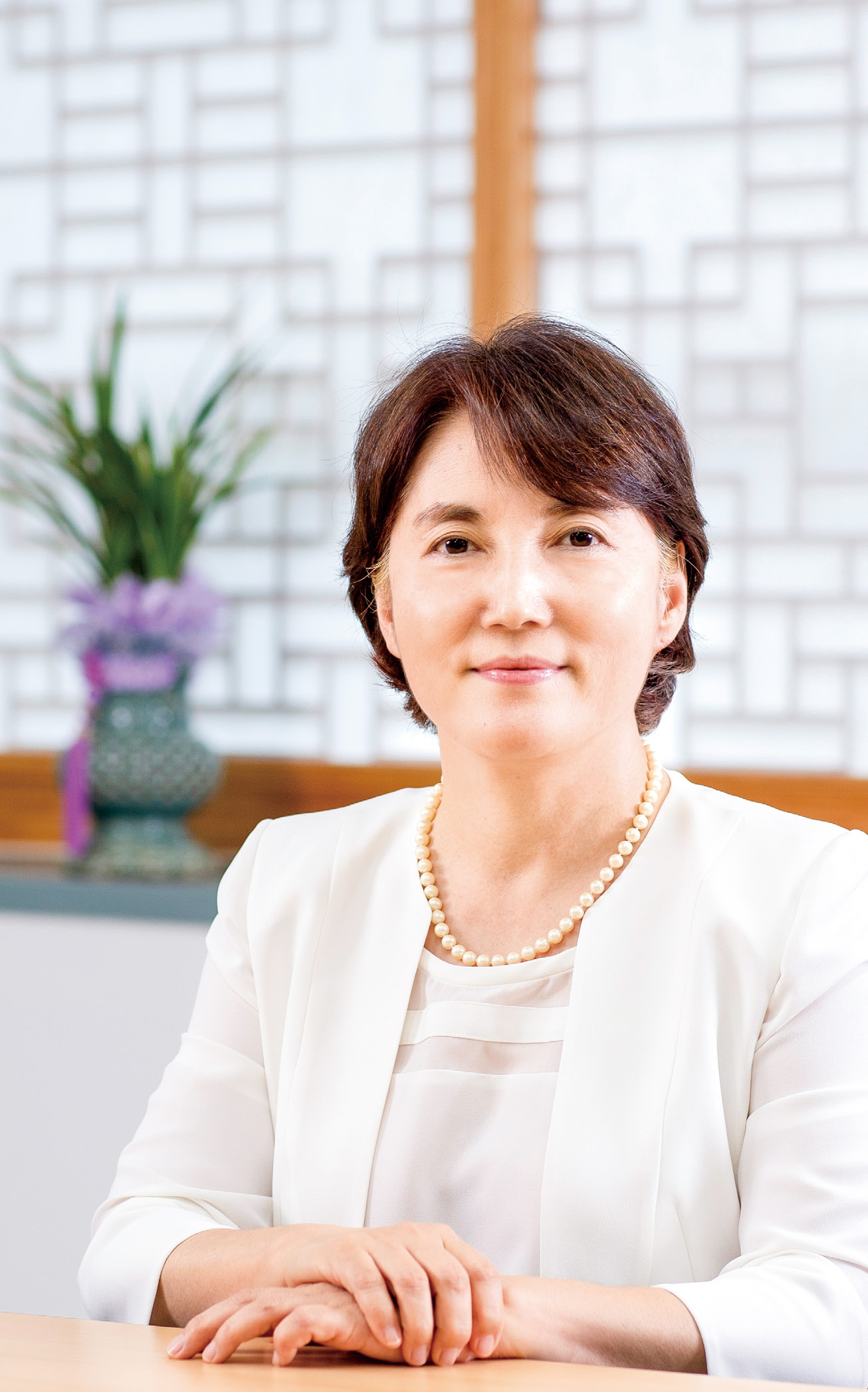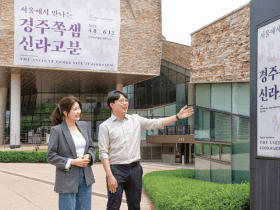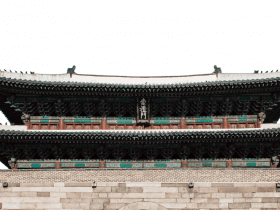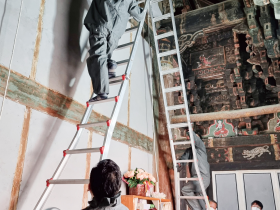

In February, the National Research Institute of Cultural Heritage (NRICH), which has been dedicated to research major cultural heritage in Korea, changed its official Korean name, reflecting its elevated status. The Korean name was changed from Gungnim Munhwajae Yeonguso to Gungnim Munhwajae Yeonguwon after 27 years to differentiate the headquarters from its seven regional institutes and respond to the transition to a digital society and development of advanced technologies. We met Director General Kim, Yeonsoo, who took helm of the newly named National Research Institute of Cultural Heritage to listen to her thoughts on the inauguration and her goals as the Director General.
How do you feel about taking the office as the new Director General of the National Research Institute of Cultural Heritage?
I have both expectations and burdens as I take charge of the National Research Institute of Cultural Heritage (NRICH), a research institute affiliated with the Cultural Heritage Administration and has been supporting heritage policies for a long time. The NRICH is the only national institute related to heritage in Korea and has been at the forefront of researching, preserving and restoring Korea’s cultural heritage over the past five decades with remarkable results. In 2022, the institute changed its official Korean name reflecting its elevated status. I feel some pressure by taking office at an important time, but my excitement and anticipation is greater as I think of working together with the people who love Korea’s cultural heritage.
You have been engaged in public duties for a long time. Please tell us the most rewarding moment among your achievements.
I have taken interest in history and culture since childhood, so it was natural for me to pursue the path in historical studies. Beginning as a curator, I was able to have a variety of experiences at the National Palace Museum of Korea, the National Intangible Heritage Center and the National Research Institute of Maritime Cultural Heritage.
At the National Palace Museum of Korea, I was able to see various exhibitions and connect with the people through the exhibits and found a new joy in exploring the royal culture. At the National Intangible Heritage Center, I broaden my perspective on cultural heritage as I realized that I was biased toward tangible cultural assets. The times at the National Research Institute of Maritime Cultural Heritage allowed me to explore the mystery of relics in the sea as well as to realize the difficulties coming from the field researches. On top of that, I was able to broaden the scope of cultural heritage research from the Korean peninsula to the East Sea, West Sea and South Sea. In 2015, I worked as the Director of International Affairs Division at the Cultural Heritage Administration and experienced the new field of having Korea’s cultural heritage internationally recognized such as the return of Deokjong Eobo, a Joseon era royal stamp, the registration of the Baekje Historic Areas to the UNESCO World Heritage List and Juldarigi, or Tugging Rituals, to the UNESCO’s Intangible Cultural Heritage of Humanity, gaining a sense of accomplishment through the process.
Instead of choosing one particular achievement during my public service, I will do my best in assisting the NRICH and its researchers in making bigger achievements based on my experiences.
You served as the directors of the National Palace Museum of Korea, the National Intangible Heritage Center and the National Research Institute of Maritime Cultural Heritage before inaugurating as the director general of the NRICH. In your opinion, what distinguishes the NRICH from other institutions?
The NRICH is the only institution specializing in cultural heritage research in Korea, which has grown rapidly over the past 50 years and is now on a stable track. Korea also has become a country internationally known for state-of-the-art technology, and various world-class level cutting-edge scientific methods are applied to the field of cultural heritage research. Cultural heritage research is centering on mid to long-term on-site research plans, instead of researches based on existing collections, as the country itself is a historical site and relic for studies. We are also expanding the field of research on cultural heritage by encompassing natural heritage as well as cultural heritage in Korea. Cultural heritage research is a major humane studies and it should be for the people. I am confident that we could be more creative by pursuing convergence research with assistance from natural science.
As the nation’s top institute specializing in cultural heritage in Korea, what do you think is the ideal image of the NRICH?
When we research something, we might be concerned about the economic value of the project by quantifying the result and wondering whether the result would bring economic benefits. However, research on heritage is difficult to evaluate in those economic value or the amount of money, hence it is very important to work with pride than anything else. As the NRICH is funded by the state, we cannot avoid evaluation, but the researches we conduct are pump-priming studies with potential added value in the future as seen in the rapid growth of hallyu, or Korean wave. So the NRICH will strive to be a righteous, devoted and future-oriented institution.
What do you want to focus on during your tenure?
Research on cultural heritage is conducted on the entire territory of Korea, and it is true that current manpower in the field of cultural heritage research is not sufficient to cover the whole country. However, given the nature of a state-funded national research institute, if we are not likely to recruit more researchers, I think it is important to understand the competency and strength we have and create a system to maximize it. For example, as the country’s sole cultural heritage research institution, we have an extensive documents and materials accumulated over the last 50 years. So we plan to systematically organize, classify and use the data through efficient and systematic operation of the institution.


Lastly, is there a message you want to convey to the researchers as well as the readers of the NRICH magazine?
First of all, I want to express my sincere gratitude. I am always grateful for the researchers’ hard work at sites across the country for excavation and research on the major ancient cultures of Korea including Silla Kingdom, Baekje Kingdom and Gaya confederacy despite the lack of workforce in the main office as well as regional institutes. Recently, the gold leaf relic from Silla era, excavated from the Donggung Palace and Wolji Pond in Gyeongju, North Gyeongsang Province, is extremely small with the size of 3.6-centimeter-wide, 1.17-centimeter-long and 0.04-millimeter thick, which is hard to discern with naked eyes. This was discovered while sieving the soil of the site by a handful. It was almost a miracle like finding a needle in a haystack. Research on heritage is not possible without faith and affection, and I would like to express my gratitude for their efforts on site.
Also with improved communication skills through media and social media allowing people to quickly and easily obtain various information, it has increased the intellectual level, curiosity and interest of general public on cultural heritage. The “NRICH,” an English magazine by the institute, is one of the communication channel sharing the NRICH’s research accomplishments and promoting Korea’s cultural heritage overseas. We will continue to communicate through this magazine, introducing the researches conducted at the institute and sharing news in various ways so the NRICH is not just for researchers but for everyone. So please pay attention to our projects.
Due to the COVID-19 pandemic, international exchanges have been shrinking. How do you think about the NRICH’s international relations such as collaboration with overseas institutions and training at the Asia Cooperation Program on Conservation Science (ACPCS) and the international readers interested in the NRICH’s achievements?
Despite the coronavirus pandemic, we continue to share strategic cooperation related to cultural heritage with Mongolia, Kazakhstan and Egypt. We are also excavating overseas sites related to Korea’s ancient culture to find its origin despite difficulties caused by the country’s division. As a leading institution in cultural heritage research, we will continue to exchange and cooperate with cultural heritage research institutes in other countries with a sense of responsibility.


Profile of Kim, Yeonsoo
Kim Yeonsoo earned her bachelor’s and master’s degree from the Department of Archaeology and Art History at Seoul National University.
She entered public service in 1986 as a curator and worked at the Royal Museum (the forerunner of the National Palace Museum of Korea) under the Cultural Heritage Administration, the National Palace Museum of Korea and the National Research Institute of Cultural Heritage.




